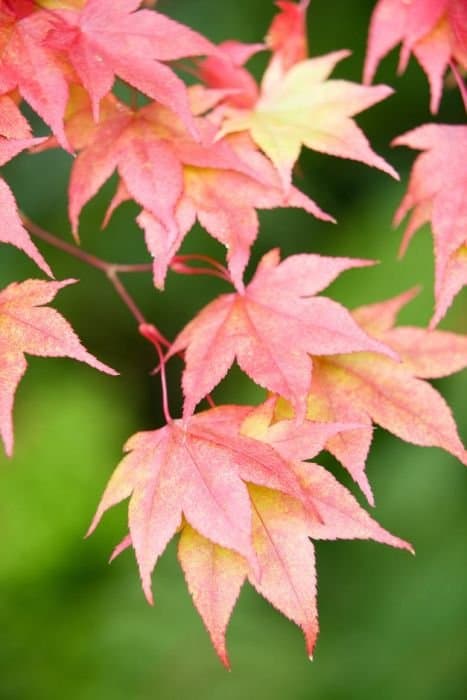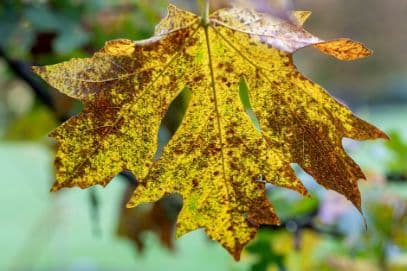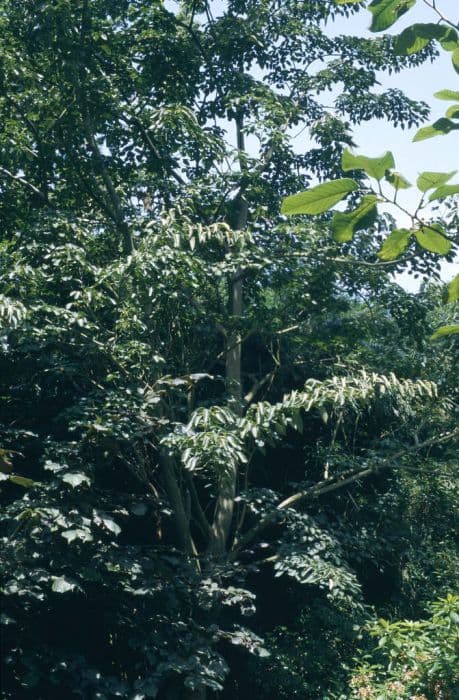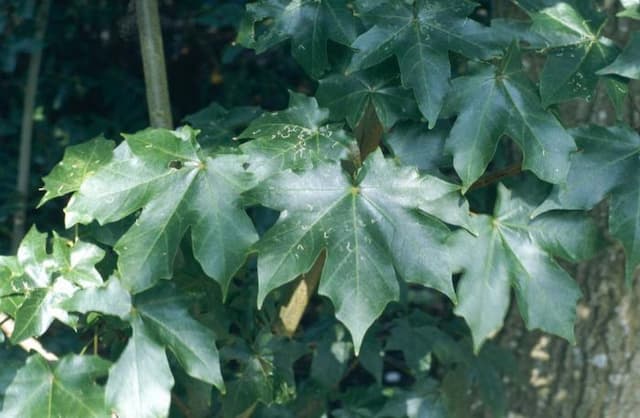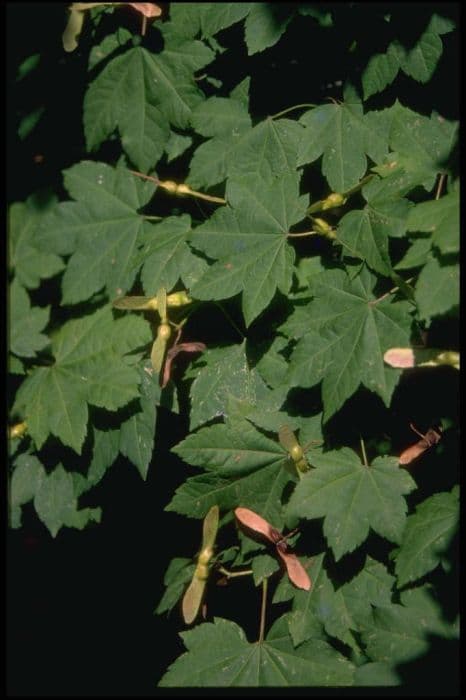Horse chestnut 'Hampton Court Gold' Aesculus hippocastanum 'Hampton Court Gold'

ABOUT
'Hampton Court Gold' is a large, deciduous tree with a broad, roundedcrown. Its palmately-lobed leaves emerge soft yellow in spring, turning greenish-yellow in summer and golden-yellow in autumn. White flowers with a yellow blotch are followed by spiny green chestnuts that turn brown with age
About this plant
 Names
NamesSynonyms
Horse Chestnut, Conker Tree.
Common names
Aesculus hippocastanum 'Hampton Court Gold'.
 Characteristics
CharacteristicsLife cycle
Perennials
Foliage type
Deciduous
Color of leaves
Green
Flower color
White
Height
50 feet (15 meters)
Spread
40 feet (12 meters)
Plant type
Tree
Hardiness zones
5
Native area
Southeast Europe
Benefits
 General Benefits
General Benefits- Decorative Foliage: The 'Hampton Court Gold' variety of Horse Chestnut is known for its striking golden foliage which adds a splash of vibrant color to the landscape.
- Shade Provision: Grows into a large tree that offers considerable shade, making it suitable for parks and large gardens.
- Ornamental Flowers: It produces showy white flowers with a yellow to pink blotch, adding ornamental value during the blooming season.
- Urban Tolerance: This species can tolerate urban pollution to a certain extent, making it suitable for city planting.
- Wildlife Attraction: The flowers provide nectar and pollen for bees and other pollinating insects, while the seeds can serve as food for wildlife.
- Seasonal Interest: Horse Chestnut trees have a distinct seasonal change, offering a variety of looks throughout the year.
- Large Structure: Its large size and spreading canopy can make for a magnificent specimen tree in the right setting.
- Erosion Control: The strong root system can help stabilize the soil and control erosion on slopes.
 Medical Properties
Medical Properties- Venous insufficiency: Extracts of Aesculus hippocastanum, commonly known as horse chestnut, are used to help reduce symptoms of venous insufficiency, such as varicose veins.
- Anti-inflammatory: Horse chestnut is thought to have anti-inflammatory properties, which may help in reducing the swelling associated with chronic venous insufficiency.
- Edema: The plant has been used to reduce fluid retention, particularly in cases of leg edema related to venous issues.
- Hemorrhoids: Due to its purported vascular protection and anti-inflammatory effects, extracts from the horse chestnut may be used to ameliorate the discomfort caused by hemorrhoids.
 Air-purifying Qualities
Air-purifying QualitiesThis plant is not specifically known for air purifying qualities.
 Other Uses
Other Uses- Water Purification: The crushed seeds of the Horse Chestnut can be used as a form of bio-filter, helping to clarify water by precipitating suspended solids due to the saponins present.
- Laundry Detergent: Natural saponins found within the Horse Chestnut seeds can be used as a laundry soap for washing clothes, especially when seeking ecological alternatives to chemical detergents.
- Fish Stunner: Historically, the saponins in Horse Chestnut seeds were used to temporarily stun fish, making them easier to catch without long-term harm to the fish population.
- Photographic Plates: Horse Chestnut starch has been used historically in the preparation of certain types of photographic plates due to its fine, even grain.
- Furniture Polish: The conkers or seeds, once finely ground and mixed with water, can create a milky substance that can be used to polish and clean wooden furniture.
- Metal Cleaning Agent: Aesculus hippocastanum seed extracts have been utilized for cleaning and shining metal surfaces, providing a natural alternative to chemical metal cleaners.
- Companion Planting: Planting Horse Chestnut trees in the landscape can deter certain pests from gardens, as some insects find the tree's compounds unappealing.
- Leather Softener: The saponins from Horse Chestnut can be used in the leather tanning process to soften and condition the leather.
- Ink Production: The bark of the Horse Chestnut tree contains tannic acid, which can be used as an ingredient in the production of natural inks.
- Horticultural Mold Release: Powdered Horse Chestnut seeds can be dusted on molds for casting metals or ceramics to act as a separating agent, allowing easy mold release.
Interesting Facts
 Feng Shui
Feng ShuiThe Horse Chestnut is not used in Feng Shui practice.
 Zodiac Sign Compitability
Zodiac Sign CompitabilityThe Horse Chestnut is not used in astrology practice.
 Plant Symbolism
Plant Symbolism- Strength and stability - As a member of the horse chestnut family, Aesculus hippocastanum 'Hampton Court Gold' represents the solid and enduring qualities of trees, suggesting resilience and reliability.
- Protection - The horse chestnut is often associated with protective qualities, possibly due to its robust nature and the fact that it has been traditionally used to craft amulets believed to guard against negative energies.
- Prosperity - The nuts of the horse chestnut tree have been seen as symbols of abundance and prosperity, stemming from their resemblance to chestnuts which were historically valuable sources of food.
- Healing - In folk medicine, horse chestnut has been used for its supposed healing properties, which may extend to its symbolism, carrying connotations of health and well-being.
 Water
WaterThe Horse Chestnut tree should be watered deeply, allowing the soil to moisten to a depth of several inches. Young trees need more frequent watering, about once a week, especially during dry spells. As it matures, watering can be reduced, and the tree will be more tolerant of drought. It's important to ensure the soil is not waterlogged, as this can lead to root rot. Typically, during the growing season, apply around 1.5-2 gallons per inch of trunk diameter at each watering session, tapering off as the tree becomes established.
 Light
LightThe Horse Chestnut prefers full sun to partial shade for optimal growth. It thrives best in a location that receives at least six hours of direct sunlight daily, but it can also tolerate some light afternoon shade. Avoid planting it in deep shade, as this can result in reduced flowering and a less robust tree.
 Temperature
TemperatureThe Horse Chestnut is hardy and can withstand a wide range of temperatures, but it performs best in areas with cool to moderate climates. It can survive in temperatures as low as -20°F and as high as 100°F, but ideal conditions range between 50°F and 75°F. Extreme heat or cold may stress the tree, particularly when it is young.
 Pruning
PruningPruning the Horse Chestnut is mainly done to remove dead, damaged, or diseased branches to maintain tree health and appearance. The best time to prune is during the dormant season, in late winter or early spring, before new growth starts. Pruning should be carried out as needed, typically every few years, to keep the tree's structure sound and to promote strong growth.
 Cleaning
CleaningAs needed
 Soil
SoilThe Horse Chestnut prefers a well-drained, fertile soil with a pH ranging from 6.0 to 7.5. A mix of loam, organic compost, and a small amount of sand for drainage creates an ideal growing medium for this tree.
 Repotting
RepottingHorse Chestnut trees, being large and typically outdoor trees, are not usually repotted. They are planted in the ground where they can spread their roots indefinitely.
 Humidity & Misting
Humidity & MistingHorse Chestnuts are not particularly sensitive to humidity levels as they are adaptable to a wide range outdoors, thriving in the ambient humidity of their environment without the need for specific adjustments.
 Suitable locations
Suitable locationsIndoor
Not suitable for indoor growing due to size.
Outdoor
Plant in full sun, provide ample water, and ensure well-draining soil.
Hardiness zone
4-7 USDA
 Life cycle
Life cycleThe common name for Aesculus hippocastanum 'Hampton Court Gold' is the horse chestnut. The life cycle begins with the germination of the conker, which is the large, shiny brown seed of the tree. Upon sprouting, the seedling grows into a sapling, a young tree that gradually establishes its root system. As it matures, the horse chestnut develops a broad, domed crown of branches and typically blooms in spring with panicles of yellow flowers, distinctive of the 'Hampton Court Gold' variety. Throughout its life, the tree undergoes seasonal changes, shedding its leaves in the autumn. Eventually, after years of growth, which can span several decades, the tree reaches its full maturity and begins the cycle again by producing conkers, thus propagating the species.
 Propogation
PropogationPropogation time
Spring to early summer
The most popular method of propagation for the horse chestnut tree, specifically the Aesculus hippocastanum 'Hampton Court Gold', is through seed sowing. The best time to collect seeds is in the autumn when they fall from the tree. Begin by selecting fully ripened, brown seeds that have not been damaged or begun to rot. It is preferable to plant the seeds soon after collection as they do not store well and their viability decreases over time. The seeds should be planted about 2 inches deep in a well-draining soil mixture. Place the pots in a cold frame or a similarly protected outdoor environment during the winter to stratify, as this cold period is necessary to break the seed's dormancy. Come spring, with warmer temperatures, the seeds will germinate and can then be grown on until they are ready to be transferred to their permanent location.
